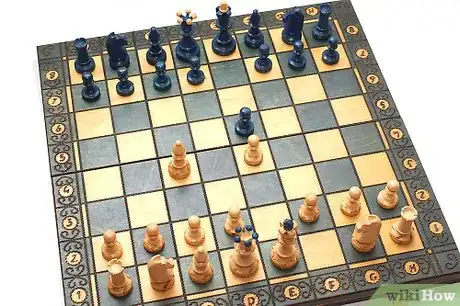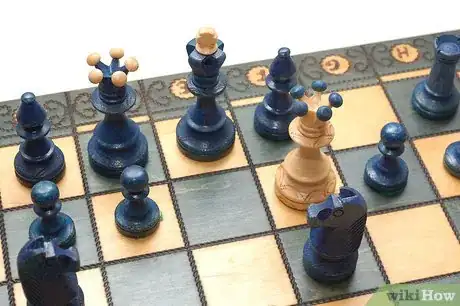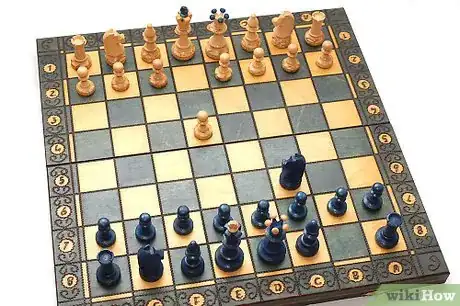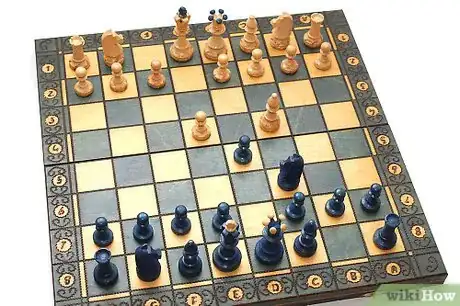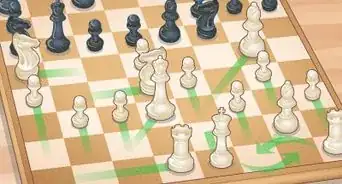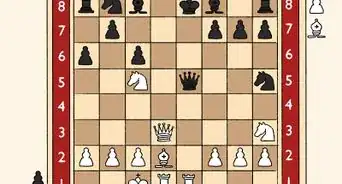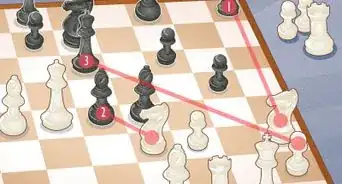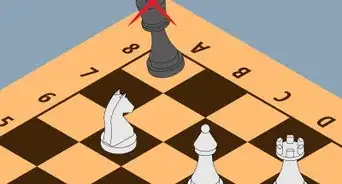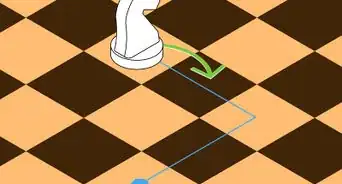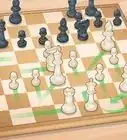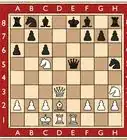This article was co-authored by Vitaly Neimer. Vitaly Neimer is an International Chess Master and Certified Professional Chess Coach with over 15 years of training experience. He has been a part of the United States' Webster SPICE national chess champion team and is also a two-time Israeli national chess champion.
There are 9 references cited in this article, which can be found at the bottom of the page.
wikiHow marks an article as reader-approved once it receives enough positive feedback. In this case, several readers have written to tell us that this article was helpful to them, earning it our reader-approved status.
This article has been viewed 241,211 times.
Scholar's Mate (also known as “Mate-in-Four”) is a famous chess play used to achieve a checkmate within as few as four moves of the start of a game. The idea is to launch a focused attack on Black’s king's bishop's pawn in order to gain control of the F7 square and earn a quick victory. Keep in mind that while Scholar’s Mate might allow you to dominate an inexperienced player, it may not work as handily on more advanced chess buffs.
Steps
Performing the Play
-
1Choose to play White. Scholar’s Mate only works if you’re in control of the white pieces, since the person playing White has the privilege of making the first move. If your opponent insists on starting off as White, you’ll have no choice but to wait until the next game to trade places.[1]
- If you’re forced to play Black, skip ahead to the section on defending against Scholar’s Mate to learn how you can avoid falling victim to the play yourself.
-
2Begin the game by moving your king's pawn forward two squares from E2 to E4. This will get it out of the way so you can sneak your king’s bishop out from the rear. Since moving a pawn two squares is a common opening move, an unsuspecting opponent will have no reason to think that they’re walking into a trap.[2]
- The term “king’s pawn” simply refers to the pawn positioned directly in front of the king.
- The squares on a chessboard are labelled to help players keep track of their movements. If you’re facing the board, the first square in each row has a corresponding letter (A through H), while the forward squares are numbered from 1 to 8.
Advertisement -
3Move your king’s bishop out 3 squares diagonally from F1 to C4. Slide the piece out to the left through the gap created by your opening move. In this position, it will threaten your opponent's king’s bishop's pawn, which sits at F7.[3]
- Don’t worry if your opponent advances their F7 pawn on their opening move. You’ll still be able to get into the position you need to secure a quick checkmate.
-
4Advance your queen 4 squares diagonally from D1 to H5. Move your queen out to the right, in the opposite direction that you moved your bishop. It will now also be a threat to the F7 pawn.[4]
- At this point, an opponent who is familiar with Scholar's Mate will know what's coming. See the section below for more information about how Black can block the ploy.
-
5Capture the king's bishop's pawn at F7 with your queen for checkmate. Once your opponent makes their next move, all that’s left to do is slide your queen over two squares diagonally to F7. This will leave them with nowhere to move their king that it won’t be endangered by your queen. They also won’t be able to take your queen in retaliation, as it’s being protected by your bishop.[5]
- You also have the option of taking the F7 pawn with your bishop instead of your queen, but doing so wouldn’t result in a checkmate.
-
6Point out the checkmate if your opponent doesn’t see it. If necessary, you can explain the steps you took to get there and demonstrate that there’s no move they can make to save their king. Then, set the board back up and start a new game!
- Keep in mind that you probably won’t be able to use this play more than once against the same opponent. Scholar’s Mate isn’t the kind of trick most people will fall for again once they understand how it works.
Defending Against Scholar's Mate as Black
-
1Play your first move however you want. It makes no difference what your opening move is. At this point, you’re just waiting for your opponent to develop their king’s bishop so you can mount an appropriate defense.[6]
- To “develop” a piece means to move it out of its starting position. Generally speaking, the more pieces you have developed than your opponent, the more of an advantage you’ll have over them.[7]
-
2Move your king’s pawn one square or your queen's pawn two squares. This will take your king’s pawn from E7 to E6 and your queen’s pawn from D7 to D5, respectively. Either way, White's bishop will no longer be a threat to F7.[8]
- This is a crucial move, as you can’t allow your opponent to place their bishop in a position where it will be able to provide support for their queen.
Note: If you opened up and moved your king's pawn two steps forward already, skip to step 3.
-
3Make any move that protects F7. Use your next turn to prevent your opponent from gaining control of the square at all costs. Some moves include:[9]
- Move your Queen to F6 if you moved your king's pawn forward two steps to open. This allows your queen to open and protect F7 at the same time. This is the recommended way.
- Move your king's Knight to H6. This allows it to take control of F7.
- Move your queen's Bishop to E6. Your bishop can protect F7 this way.
- Since your opponent’s attention will be wholly focused on claiming the F7 square, yours should be, too.
Warning! Do not move your G pawn to G7 to block the Queen's way if your King's pawn is at E5. The queen can capture your E pawn and then diagonally capture your rook, so this is the worst possible move.
-
4Concentrate on blocking White queen’s attack on future turns. If your opponent has developed their queen to F3, for instance, take your F7 pawn to F6 or your queen’s knight from G8 to F6 to halt her advance. If White’s queen is already on H5, your best defense is to move your G7 pawn to G6 to stop the queen and force a retreat without trapping your bishop.[10]
- G7-G6 will only work if you have a piece on either E7 or E6 (in front of the King). Otherwise, White can move their queen to E5, forking your king and rook. This will place your king in check, enabling your opponent to freely capture your rook.
- The queen is the most maneuverable and therefore most powerful piece on the board. For this reason, it’s important to make sure that your opponent doesn’t have a chance to use their queen to get you into a defenseless position.[11]
Expert Q&A
-
QuestionDoes the Scholar's Mate work?
 Vitaly NeimerVitaly Neimer is an International Chess Master and Certified Professional Chess Coach with over 15 years of training experience. He has been a part of the United States' Webster SPICE national chess champion team and is also a two-time Israeli national chess champion.
Vitaly NeimerVitaly Neimer is an International Chess Master and Certified Professional Chess Coach with over 15 years of training experience. He has been a part of the United States' Webster SPICE national chess champion team and is also a two-time Israeli national chess champion.
International Chess Master It depends on who you are playing against. If you go for Scholar's Mate against someone who knows how to defend against it, you’ll only be putting yourself in a worse position. This is because when you play Scholar's Mate, you have to develop your queen straightaway, which leaves her open for attack.
It depends on who you are playing against. If you go for Scholar's Mate against someone who knows how to defend against it, you’ll only be putting yourself in a worse position. This is because when you play Scholar's Mate, you have to develop your queen straightaway, which leaves her open for attack. -
QuestionI'm a beginner, what are some useful tips to defeat my opponent?
 DonaganTop AnswererA beginner should develop the habit of carefully considering every piece on the board before making a move. Each of your pieces should be viewed for its opportunities to help you, and each of your opponent's pieces should be viewed for its opportunities to hurt you. Don't be in a hurry to make a move. Normal chess is not intended to be a fast game.
DonaganTop AnswererA beginner should develop the habit of carefully considering every piece on the board before making a move. Each of your pieces should be viewed for its opportunities to help you, and each of your opponent's pieces should be viewed for its opportunities to hurt you. Don't be in a hurry to make a move. Normal chess is not intended to be a fast game. -
QuestionShould I feel bad if I accidentally fall for Scholar's Mate?
 DonaganTop AnswererChess is a difficult and complicated game. Never feel bad if you make a mistake. Every player makes them.
DonaganTop AnswererChess is a difficult and complicated game. Never feel bad if you make a mistake. Every player makes them.
Warnings
- Be aware that most experienced players will be able to spot your intentions from a mile away, which will only leave your queen vulnerable. Exposing your queen early on without developing your other pieces will put you at a decided disadvantage.⧼thumbs_response⧽
References
- ↑ https://www.chessstrategyonline.com/content/tutorials/how-to-start-a-game-of-chess-first-moves-white
- ↑ https://www.chess.com/article/view/the-4-move-checkmate
- ↑ http://www.chesscorner.com/tutorial/basic/scholars/scholars.htm
- ↑ https://www.chess.com/article/view/the-4-move-checkmate
- ↑ https://www.youtube.com/watch?v=l4g4UvZZDLo&feature=youtu.be&t=159
- ↑ https://www.chessstrategyonline.com/content/tutorials/basic-checkmates-queen-on-f7
- ↑ https://www.chesskid.com/article/view/the-glossary-for-chess-kids-and-parents
- ↑ https://www.chesskid.com/article/view/whos-afraid-of-the-four-move-checkmate
- ↑ https://www.chess.com/article/view/the-4-move-checkmate


